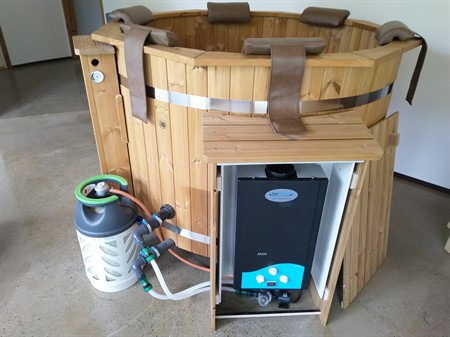There’s nothing quite like sinking into a warm hot tub after a long day, especially in cooler climates—but behind that perfect soak is a well-functioning heater. Understanding and properly caring for it is key to maximizing your hot tub’s comfort, efficiency, and long-term performance. In this guide, we’ll explore how hot tub heating works, the types of heaters available, how to choose the right one, and key maintenance tips.
The Basics of Hot Tub Heaters
Hot tubs use a self-contained system to filter, heat, and recirculate water. Different models won’t have the exact same parts, but many heaters share the following core components:
- Filtration Unit: Hot tubs have filters to collect debris and impurities. They protect the hot tub’s internal components from damage and ensure your water is clear and safe to use.
- Heater Unit: This heating element is the most crucial part of hot tubs. It can be electric, gas, or propane-based. Regardless of the specific type, the heater works with a thermostat to warm the water and maintain your desired temperature.
- Circulation System: Hot tubs use powerful pumps to pull water and push it through the filters and heater. Once the water is warm, these pumps send it back into the tub. By constantly circulating the water, this system ensures even heat distribution and avoids water stagnation.
- Insulation: Although heaters are primarily responsible for warming water, they perform most efficiently with proper insulation. It helps retain heat and reduces strain on the heating unit. Common types include spray foam, thermal shields, and fiber board.
Types of Hot Tub Heaters
Several types of heaters are available to suit different environments, budgets, and user preferences. Let’s go through each option and its ideal use cases:
1. Electric Heaters
These are the most common options for residential hot tubs. Electric heaters are compact, easy to install, and compatible with most portable tubs. They use an internal electric element to warm the water as it passes through the heater. While convenient, electric models tend to have higher long-term energy costs and heat water slowly.
2. Gas Heaters
Powered by natural gas or propane, gas heaters are ideal for larger hot tubs or in cold-climate regions where fast heating is a priority. They are also appealing in areas where gas power is more affordable than electricity. However, they require professional installation, proper ventilation, and access to a fuel source.
3. Wood-Fired Heaters
Ideal for remote areas, wood-fired heaters use burning logs to warm the water. They’re off-grid, energy-independent, and create a rustic feel. However, they require manual operation and offer limited temperature control.
4. Heat Pump Heaters
These heaters extract heat from the surrounding air and transfer it to the water using a heat exchanger. While heat pump heaters take longer to heat water, they are incredibly energy-efficient and ideal for users who soak often and want to reduce their electricity bills over time.
How to Pick the Right Heater
Choosing the right hot tub heater is about balancing your needs and long-term efficiency. By evaluating these factors, you can find a solution that delivers consistent performance:
- Climate
If you live in a region with cold winters or fluctuating temperatures, you’ll need a reliable, high-output heater (such as a gas or electric type) to maintain consistent warmth. In contrast, warmer or sunnier climates may benefit from more energy-efficient options, like heat pumps. - Usage Frequency
Individuals who frequently or spontaneously use hot tubs benefit from heaters that maintain or quickly reach the desired temperature, like electric or gas models. Contrarily, a slower but energy-efficient system may be more economical for occasional use, such as heat pump heaters. - Installation and Energy Source
Assess your installation options and access to energy sources. Electric heaters are simple and affordable to install, while gas heaters often require permits, ventilation systems, and professional setup. Wood-fired heaters are budget-friendly if firewood is available. - Budget
The initial cost versus long-term savings and energy goals should be weighed carefully. Electric heaters are affordable upfront but cost more to run. Wood-fired heaters are also economical, especially if you have inexpensive firewood. Gas and heat pump systems cost more upfront, but offer substantial long-term savings.
Maintenance Tips for Hot Tub Heaters
Keeping your hot tub heater in good condition ensures its consistent performance and extends its lifespan. Here are some fundamental care practices you must do:
1. Regular Cleaning
Every week, remove and rinse the filter units with water to clear out stuck dirt. Flush and clean the heating element and circulation system monthly to prevent the buildup of debris and mineral deposits. If you live in a region with hard water, descaling the heating element every few months is paramount, as limescale can reduce efficiency and lead to overheating.
2. Inspect Components
Perform routine inspections and look out for signs of corrosion, leaks, loose wiring, or electrical damage. Periodically test the thermostat and temperature sensors (if included in your hot tub’s model) to make sure they’re functioning accurately. Faulty sensors can lead to heating problems and should be replaced promptly.
3. Seasonal Care
In colder months, insulating your hot tub and its plumbing can prevent heat loss and reduce strain on the heater. If you aren’t planning to use it for long periods or during winter, drain the system completely and store it properly to avoid freezing damage.
4. Proper Cover
Always cover your hot tub with an insulated lid when not in use to reduce heat loss and keep debris out of the water.
Conclusion
Hot tub heating plays a big role in your overall spa experience. By choosing the right heater and following a simple maintenance routine, you can enjoy warm, relaxing soaks year-round. If you’re planning a new setup or upgrade, consult with a hot tub professional to find the best fit for your needs, budget, and energy goals.

